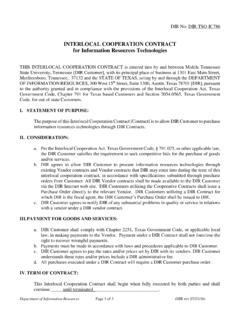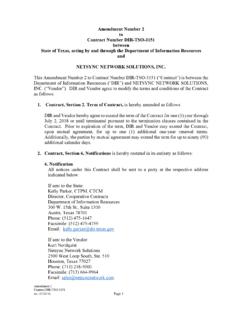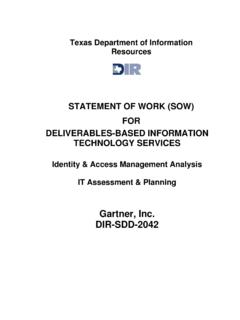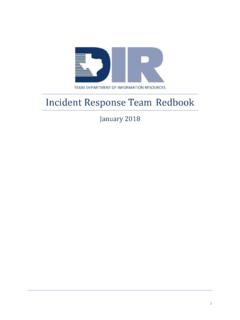Transcription of Security Control Standards Catalog V1 - Texas
1 Security Control Standards Catalog Version Texas Department of Information Resources 2/26/2016 Texas Department of Information Resources | Office of the Chief Information Security Officer ii Security Control Standards Catalog Contents About the Security Control Standards Catalog .. 1 Document Life Cycle .. 1 Revision History .. 2 Scope .. 2 Exceptions .. 2 Control Details and Sample Format .. 2 Notes on the Control Details and Sample Format .. 2 Security Controls Standards .. 4 AC Access Control .. 4 AP Authority and Purpose .. 21 AR Accountability, Audit, and Risk Management .. 23 AT Awareness and Training .. 29 AU Audit and Accountability .. 32 CA Security Assessment and Authorization .. 43 CM Configuration 49 CP Contingency Planning .. 57 DI Data Quality and Integrity .. 66 DM Data Minimization and Retention.
2 68 IA Identification and Authentication .. 71 IP Individual Participation and Redress .. 79 IR Incident Response .. 82 MA Maintenance .. 90 MP Media Protection .. 95 PE Physical and Environmental Protection .. 101 PL Planning .. 114 PM Program Management .. 119 PS Personnel Security .. 132 RA Risk Assessment .. 138 SA System and Service Acquisition .. 142 SC System and Communication Protection .. 156 SE Security .. 182 SI System and Information 184 TR Transparency .. 196 UL Use Limitation .. 199 Appendix A. NIST Control Families .. 201 Appendix B. Acronyms and Abbreviations .. 213 Appendix C. Glossary of Terms .. 215 Texas Department of Information Resources | Office of the Chief Information Security Officer Security Control Standards Catalog | ABOUT THE Catalog 1 About the Security Control Standards Catalog The purpose of this Security Control Standards Catalog ( Control Catalog ) is to provide state agencies and higher education institutions (subsequently referred to as state organizations) specific guidance for implementing Security controls in a format that easily aligns with the National Institute of Standards and Technology Special Publication 800-53 Version 4 (NIST SP 800-53 Rev.)
3 4). The Control Catalog specifies the minimum information Security requirements that state organizations must use to provide the appropriate levels of information Security according to risk levels. The Control Catalog specifies the purpose, levels of risk, implementation overview, and implementation examples for each Control activity. See the Control Details and Sample Format section for further detail. For more information related to information Security requirements for state organizations, refer to Texas Administrative Code (1 TAC 202). Document Life Cycle The Texas Department of Information Resources (DIR) will review the controls in this document each biennium. As changes in technology, threats, and risks are identified, DIR will work with representatives from state organizations to develop the controls necessary to maintain reasonable Security measures to protect state resources.
4 Prior to publishing new or revised Standards , DIR will solicit comments on new controls from Information Resources Managers and Information Security Officers at state organizations. All recommended changes will be presented to DIR s board for approval. To minimize their impact on state organizations, the required controls in the controls Catalog will be phased in over a period of three years, with no new controls in the first year. Additionally, new controls will be implemented with a required by date not to exceed 18 months, after which, all state organizations must adhere to the new standard. JunDecJa nJun State Strate gic Plan and LAR DevelopmentITCHE and D IR Board Review Regular LegislativeSession DIR drafts new Security Controls Standards in response to legislation or needODD-NUMBERED YEARSEVEN-NUMBERED YEARS Office of the Chief Information Security Officer | Texas Department of Information Resources 2 ABOUT THE Catalog | Security Control Standards Catalog Revision History VERSION UPDATED BY DATE CHANGE DESCRIPTION DIR Office of the Chief Information Security Officer 3/23/14 Released Draft Version DIR Office of the Chief Information Security Officer 10/22/14 Released Draft Version DIR Office of the Chief Information Security Officer 3/17/15 Released Final Version
5 DIR Office of the Chief Information Security Officer 4/3/15 Corrected date on cover; added missing legacy TAC references in Appendix A; ensured resulting pdf is fully searchable. DIR Office of the Chief Information Security Officer 2/26/16 Modified or corrected examples for AC-23, AC-24, AC-25, AR-5, CM-8, PM-7; Corrected TAC 202 reference in PL-1, SC-13; Added Program Management Controls to Appendix A. Scope Below is the inventoried list of NIST controls groups that are included in this Catalog . See the Control Details and Sample Format section for a description of how information on each Control is presented. NIST Control GROUPS/ABBREVIATIONS AC Access Control AP Authority and Purpose AR Accountability, Audit, Risk Management AT Awareness and Training AU Audit and Accountability CA Security Assessment and Authorization CM Configuration Management CP Contingency Planning DI Data Quality and Integrity DM Data Minimization and Retention IA Identification and Authentication IP Individual Participation and Redress IR Incident Response MA Maintenance MP Media Protection PE Physical and Environmental Protection PL Planning PM Program Management PS Personnel Security RA Risk Assessment SA System and Services Acquisition SC System and Communications Protection SE Security SI System and Information Integrity TR Transparency UL Use Limitation Exceptions Any exception to the following controls shall be approved, justified and documented in accordance with 1 TAC (c), 1 TAC (1)(G)
6 , and TAC (a6) Office of the Chief Information Security Officer | Texas Department of Information Resources 2 ABOUT THE Catalog | Security Control Standards Catalog Control Details and Sample Format Each Control group is organized under its group identification code and title, , AC ACCESS Control ([NIST Domain Name abbreviation] [Unabbreviated NIST Control family description, , Access Control ]). Information about each Control in a group is presented in the following format: Control ID-# Title [NIST 800-53 Rev. 4 Control (MOD) Control Number]-[C ontrol Name] RISK STATEMENT [A high level statement of the potential risk present by not addressing the Control activity] PRIORITY/BASELINE P1 > LOW Yes MOD Yes HIGH Yes REQUIRED BY [Date which requirement will become effective. Note: Only Low baseline controls are mandatory for all systems.]
7 Other controls may be applicable based on the state organization risk assessment] Control DESCRIPTION [Detailed NIST 800-53 Rev. 4 Control (MOD) Control description] IMPLEMENTATION STATE [State-level requirements for the implementation of information Security controls] STATE ORGANIZATION [To be determined for each organization; t o include organization-specific components as applicable, , if an organization has a specific mapping requirement under the Health Insurance Portability and Accountability Act (HIPAA; or other regulatory driver) this relative Control could be included here] COMPARTMENT [To be determined for each state organization; to include organization-specific compartment or divisional level components as applicable, , if an organization s department has a specific requirement under HIPAA, as an example, this relative Control could be included here] EXAMPLE [This section includes example only considerations of how the Control identified above may be applicable in a state organization Security environment] BACK TO CONTENTS Notes on the Control Details and Sample Format GROUP ID, GROUP TITLE, Control ID, Control TITLE The Group ID, Group Title, Control ID, and Control Titles are brought in directly from NIST SP 800-53, Rev 4.
8 By maintaining this consistent mapping, state organizations can more easily map their controls to other regulatory schemes. DIR will also maintain a mapping on its website for many of the common Security and regulatory systems. PRIORITY/BASELINE The PRIORITY/BASELINE is imported from NIST SP 800-53 and used for two distinct purposes. The BASELINEs are used to select which controls to implement and relate to the three impact levels LOW, MODERATE, or HIGH of a system. For the purposes of this version of the Control Catalog only LOW controls will be required. When those LOW controls will be required is based on their priority. Texas Department of Information Resources | Office of the Chief Information Security Officer Security Control Standards Catalog | ABOUT THE Catalog 3 PRIORITY is useful for ensuring that more fundamental controls are implemented first.
9 Controls that existed in the previous version of TAC 202 are required upon adoption by the DIR Board of the new rule and Catalog . Other NIST controls that were not required under the previous TAC 202 will be prioritized for implementation over the next two years. There are four PRIORITY levels P1, P2, P3, and P0 within NIST. LOW/P1 controls not in current TAC are required to be implemented one year after adoption by the DIR board. LOW/P2 and LOW/P3 controls not in current TAC 202 will be required two years after adoption by the DIR Board. P0 controls are not required, but are provided for consistent mapping with NIST 800-53 and to offer state organizations that choose to implement a P0 Control a location to store that information. IMPLEMENTATION A REQUIRED BY date is provided for each required Control . By phasing in requirements, DIR aims to minimize disruption to state organizations, while providing clear guidance on the minimums required to protect state resources.
10 The Control Catalog also provides an IMPLEMENTATION/STATE for each Control that is or will be required. IMPLEMENTATION/STATE is meant to align the NIST 800-53 Control with the minimum Security required by the state. For state organizations that have stronger Control requirements, either dictated by third-party regulation or required by the organizations own risk assessment, the Control Catalog also provides a space for the agency to specify both an IMPLEMENTATION/AGENCY and an IMPLEMENTATION/COMPARTMENT. As an example, an organization may have a specific type of data that requires a specific handling procedure. Thus, its IMPLEMENTATION/AGENCY would be more stringent than the state s minimum requirement. That same organization may also have a business unit or specific program area that also deals with a third type of data that has a specific breach notification requirement, thus that IMPLEMENTATION/COMPARTMENT would have a requirement that may not apply to the whole organization.








